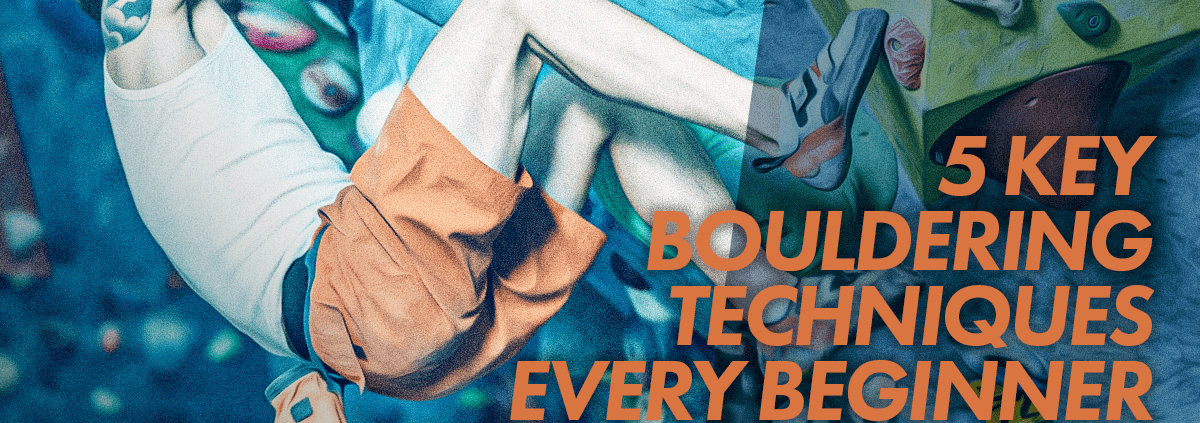5 Key Bouldering Techniques Every Beginner Should Know
There are several vital bouldering techniques every beginner can benefit from. Climbing is not just a physical activity, it’s a thrilling journey of joy and self-discovery! It doesn’t matter how often or how hard you climb; it’s about relishing the movement and triumphing over physical and mental challenges.
Whether you’ve been climbing for a while or are excited to start, check out these five critical bouldering techniques every beginner should know. Once put into practice, you’ll climb more efficiently and may even break into that next grade!
5 Key Bouldering Techniques
-
Use Your Legs!

As a beginner climber, you may think everybody muscles their way up the wall using their arms. While your grip strength is essential when climbing, it’s not the only factor that helps you get up a boulder problem. A climber who continually campuses (uses only their arms) up a boulder problem will burn out far quicker than if they used their feet.
Consider climbing this way: your hands keep you on the wall, and your legs, the powerhouses of your body, propel you higher. You’ll save tremendous energy and feel the thrill of your own strength when you use them effectively.
-
Flagging
Let’s talk about flagging, a nifty technique that can help you balance your weight on the wall. To flag, simply stick out your free foot and press it into the wall. There are several types of flags, each useful in different situations. So, don’t be afraid to experiment and find what works best for you!
Outside Flag: Imagine climbing with two hands on the wall and only a right foothold. Since the left leg isn’t doing anything here, you’ll want to stab it into the wall to keep yourself close and counterbalance your weight as you reach for the next hold.
Inside Flag: This is used when your only foothold is below your body. You’ll step your free foot between your other leg and the wall and press it into the wall when reaching for the next hold.
Doing this instead of swapping feet will make you move more efficiently and quickly—plus, you’ll save some of your energy.
Back Flag: This is common on overhung routes when you only have holds on one side of your body and need to move in the opposite direction. Say your right hand and right foot are on, and you must move left.
Placing your left foot around your right, pushing it into the wall, and leaning to the left creates a balance that helps you stay close to the wall to reach the next handhold.
-
Foot Swapping
Sometimes, a boulder problem requires you to swap your feet. You step on a hold with your left foot only to find that you must use your right foot to make the next move. An inside flag might not do the job, so you should be well-versed in practicing this new technique.
To foot swap, hover your free foot over or right next to the foot that’s on the wall. Quickly hop off the foothold and replace it with your other foot when ready. Begin with holding large holds and stepping on a big foothold. The more you practice, the smaller the footholds you can swap on!
-
Drop Knee
Now, let’s discuss the drop knee, a technique that can keep your body close to the wall. The further your body sags away from the wall, the more strength it takes to stay on the holds. So, if you need to reach for the next hold but feel you may swing off or need a quick rest to chalk up, try a drop knee. It’s especially useful on overhung routes.
You’ll have one foot higher on the wall than the other to drop knee. Twist the leg of the higher foot toward the wall until your knee is facing downward. That will help you stay close to the wall and reach your next hold.
-
Practice!
 The last critical bouldering technique beginners should know is that climbing is a journey of continuous improvement. You won’t wake up one day and immediately be able to climb V9, but with each practice, you’re one step closer to your goal. Climbing takes persistence and dedication, but the rewards are worth it.
The last critical bouldering technique beginners should know is that climbing is a journey of continuous improvement. You won’t wake up one day and immediately be able to climb V9, but with each practice, you’re one step closer to your goal. Climbing takes persistence and dedication, but the rewards are worth it.
Practice each of these techniques! As you progress through them, take your practice to more overhung walls and keep trying. Before you know it, you won’t need to think about what technique to use—you’ll automatically do it!



